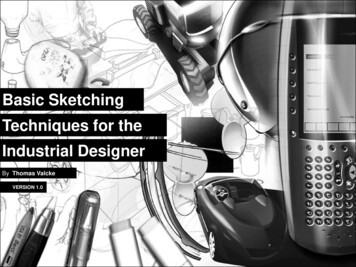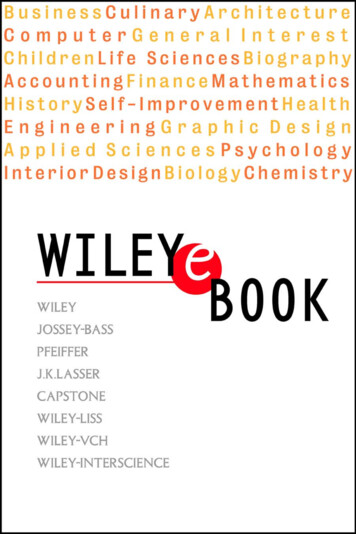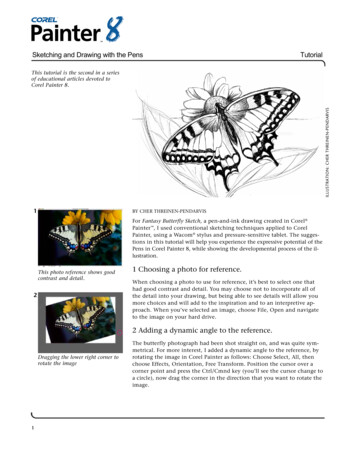
Transcription
How Do Sketching and Non-Sketching ActionsConvey Design Intent?Senthil ChandrasegaranDevarajan RamanujanNiklas ElmqvistCollege of EngineeringUniversity of California, Davisschandrasegaran@ucdavis.eduDepartment of EngineeringAarhus University, Denmarkdevr@eng.au.dkCollege of Information StudiesDepartment of Computer ScienceUniversity of Maryland, College Parkelm@umd.eduacbFigure 1. Designers use more than sketches and annotations to express intent. Our observational study revealed three main ways (along with speech) inwhich designers express intent: (a) on-the-surface “pointing” actions to indicate parts of a design, (b) above-the-surface gestures with fingers or pencilsto show movement, shape, or area, and (c) away-from-the-surface gestures, using their hands or other objects as proxies for components or assemblies.ABSTRACTINTRODUCTIONSketches are much more than marks on paper; they play akey role for designers both in ideation and problem-solvingas well as in communication with other designers. Thus, theact of sketching is often enriched with annotations, references,and physical actions, such as gestures or speech—all of whichconstitute meta-data about the designer’s reasoning. Conventional paper-based design notebooks cannot capture this richmeta-data, but digital design notebooks can. To understandwhat data to capture, we conducted an observational study ofdesign practitioners where they individually explore designsolutions for a set of problems. We identified sketching andnon-sketching actions that reflect their exploration of the design space. We then categorized the captured meta-data andmapped observed physical actions to design intent. Thesefindings inform the creation of future digital design notebooksthat can better capture designers’ reasoning during sketching.Design is not just a mental process for the designer: it alsoinvolves physical actions, such as drawing depictions on paper, making movements of a pencil or hands without creatingphysical depictions, and looking at existing depictions to interpret them [38]. These physical actions give insight into thedesigner’s thought process, and help other collaborators (andsometimes the designers themselves) understand the rationalebehind their decisions. The design notebook is typically thedesigner’s medium of choice for recording ideas. However,paper notebooks can only capture actions that mark the paper,i.e. the depictions themselves. With the recent proliferation ofhandheld computing devices, there is a rising trend in digitalapplications to replace the design notebook, but these tendto still mostly emulate paper without fully transcending themedium to also capture the rationale behind the pen marks.Hand-held personal computing devices such as smartphonesand tablets are typically used as digital design notebooks byusing their touch screen as a proxy for paper, along with theuser’s finger, a capacitive touch pen, or a dedicated stylus as asubstitute for a pencil. However, these devices are capable ofmuch more than capturing depictions on “paper.” Studies ofdesign processes have shown that the act of design ideation ismultimodal in nature: designers sketch on paper, point to orgesture over parts of their sketch, and speak to describe theirideas, raise questions, and evaluate ideas. Capture of designers’ actions has typically involved using overhead cameras thatcan record the sketches as well as the designers’ movements,which requires cumbersome equipment. When consideringdigital interfaces to capture these modes of interaction, stud-Author KeywordsSketching; ideation; observational study.ACM Classification KeywordsH.5.2 Information Interfaces and Presentation:Interfaces—Interaction stylesUserPermission to make digital or hard copies of all or part of this work for personal orclassroom use is granted without fee provided that copies are not made or distributedfor profit or commercial advantage and that copies bear this notice and the full citationon the first page. Copyrights for components of this work owned by others than ACMmust be honored. Abstracting with credit is permitted. To copy otherwise, or republish,to post on servers or to redistribute to lists, requires prior specific permission and/or afee. Request permissions from permissions@acm.org.DIS ’18, June 9–13, 2018, , Hong Kong 2018 ACM. ISBN 978-1-4503-5198-0/18/06. . . 15.00DOI: https://doi.org/10.1145/3196709.31967231
ies have suggested that encouraging and capturing speechwhile sketching was useful as it kept visual attention on thesketch, at the same time allowing the designer to convey usefulinformation [14]. Recent developments in personal computing devices have made speech-based interfaces commonplacethanks to digital voice assistants such as Alexa, Cortana, andSiri. Additionally, research directions in HCI have exploredthe combination of touch and in-air gestures on hand-helddevices [9], the use of above-the-surface sensing to anticipateuser interactions [21], and the use of 3D input with a customstylus that enables spatial interactions around a device [46].Still, these novel technologies have yet to be employed forcapturing meta-data and design rationale. Part of the reasonfor this gap in the literature may be that it is still not clearwhich meta-data to capture, and how to present it back to thedesigner to best support the creative process.with sketches, but typically use video and audio to capturethese actions. The recent developments in non-traditional interaction techniques that include tangible, haptic, verbal, andeven full-body interactions, have created an opportunity toprovide computational support for designers by capturing theirintent and rationale through their actions, speech, and sketches.In this section, we review work in the fields of design research,HCI support for ideation, and research on multimodal interactions for design.Sketching in Design IdeationSketching during design ideation typically involves quicklydrawn, loosely structured visual representations concernedwith broad features rather than detail [27]. Sketches serveas an extension to working memory, reducing the burden ofstoring and simultaneously operating on content [41]. In suchcontexts, sketches can convey both, geometric and symbolicinformation about a designers’ idea [28]. The role playedby sketches in design ideation can be broadly classified intothree themes [43], (1) “thinking sketches,” that support cognitive aspects of idea generation, exploration, and evaluation,(2) “talking sketches,” that serve as a means for communicating ideas, and (3) “storing sketches,” that act as an externalmemory aid.In order to exploit the growing sensory capabilities of handheld devices in ways that aid the design process, one needsto first understand designers’ actions and underlying intents.In this paper, we address this need by conducting an observational study of 6 experienced practitioners engaged in designideation tasks. We focus on individual designers rather thanteams, as we are interested in what actions of designers canbe used to store their ideas. Participants followed a thinkaloud protocol, exploring solutions to a given design problemusing a traditional pen-and-paper medium. We video andaudio-recorded the participants, and qualitatively coded alloccurrences of physical actions: actions that produced markson paper (such as sketching and annotating), as well as actionsthat did not (such as pointing and gesturing). We also codedall occurrences of the designer’s intent, which referred to whatthe designer was trying to do: searching for solutions, describing a design solution, or analyzing a design. By identifyingco-occurrences between the designer’s intent and the physicalactions, we determine the actions designers use to expresstheir intent. Based on this intent-to-action mapping, and basedon our observations from the study, we then formulate a set ofimplications for those seeking to create the next generation ofdigital design notebooks that offer rich interaction modalities.Understanding designers’ cognitive processes has been animportant focus area for previous research in this domain. Anearly instance of such work is Goldschmidt’s [17] analysisof “study sketches”—quick-and-dirty sketches that help thedesigner reason their way through a design space. In this work,Goldschmidt models the design process as a dialectic processbetween “seeing as”—seeing figural properties in a sketch and“seeing that”—eliciting non-figural properties from the sketch.Studies by others [16, 34] also suggest that visual display ofinformation through sketching allows reinterpretation, a vitalcomponent of design ideation. While these studies discussdesigners’ physical actions, they do so with the primary motiveof mapping them back to their cognitive processes. Suwa etal. [38] extend earlier work by Suwa & Tversky [39] and createa coding scheme for representing designers’ physical and nonphysical actions. While their work provides insights into thetypes of physical actions used and relationships among them,it does not discuss means for supporting them.The contributions of this paper are: (1) a review of researchin design methods and digital support for design to identifypotential research areas to capture and record designers’ intent,(2) a map of designers’ actions to designers’ intent based onobservational studies conducted with design practitioners, and(3) a set of implications for HCI designers and engineers forcapturing designers’ intent.Studies on design ideation indicate that, apart from sketching, designers use a diverse set of verbal and visual strategiesfor conveying ideas [35], such as pointing and verbal utterances [45]. Digital design notebooks have brought a renewedfocus on supporting such physical actions [26], but doing so requires an understanding of both the spatiotemporal propertiesas well as the intent of the designer’s actions.BACKGROUNDDonald Schön, in his paper on the challenges of computersupport for design knowledge capture [33], states, “The designer designs not only with the mind, but with the body andsenses, a fact that poses an interesting challenge to computers.” Yet, studies of designers’ behavior has largely focusedon uncovering their cognitive actions. While there are a fewbodies of work that also emphasize designers’ physical behavior, the typical focus is on design methods, and not on digitalsupport. Research on multimodal interactions for design hashighlighted the importance of using speech and actions alongDigital Support for Design IdeationSutherland’s SketchPAD [37] remains the seminal work ininteractive design applications, paving the way for ComputerAided Design (CAD) systems and digital sketching interfaces.Since then, the increasing use of digital devices in designideation has now made it possible to record and share one’svoice and physical actions along with sketches. Such actionshave been shown to be useful for communication, both with2
other designers and with one’s “future self”, who may refer tothese sketches in the future for inspiration.and gestures can be used to both convey additional informationover the sketch, and in some instances, modify the sketch toreflect designers’ intent [2]. In a later work, Adler [1] usesthis approach in a multimodal interactive dialogue system (MIDOS) that takes sketching and speech inputs from the user,uses a physics simulator to interpret the sketched structure, andinteractively asks the user to resolve ambiguities. Similarly,Bischel et al. [7] use speech features, specifically (spoken)descriptions of actions, to separate sketch strokes that portraystructure from explanatory strokes, such as arrows indicatingmotion or circles that draw focus to specific parts of the sketch.Computer support tools for creative design should thus support both individuals and teams [36]. Yet, digital supporttools for ideation that goes beyond capturing sketches has typically focused on idea sharing via sketches, such as computermediated group ideation [10, 19], team-based approaches tosketching [30, 31, 47], and immersive environments for collaborative sketching [13, 15]. Computer support for individualexploration of design spaces has primarily focused on implementing algorithmic approaches to design, such as the Theoryof Inventive Problem-Solving (TRIZ) [11], or aiding synthesisthrough shape grammar and analogy-based design [8].While most speech-based sketching technologies use the scenario of collaborative work to capture speech, studies haveshown that such technology allows users to replay the audiofrom previous ideas, and develop variations, which leads tobetter creative outcomes [32]. The notion of a designer talking by herself or to her device may have been strange in thepast, but recent proliferation in digital voice assistants suchas Alexa, Siri, and Google Assistant have made the act ofspeaking to one’s devices more commonplace. While mostof the work discussed in this section uses cumbersome laboratory setups, this is no longer necessary: the smartphoneand tablet, with its capacitive sensors, camera, microphone,inertial measurement unit, and other sensors is increasinglybetter equipped for multimodal interactions such as the onesdescribed above. Interaction modalities that use touch, grip,and in-air gestures have been suggested for context-sensitiveinteractions [9, 21]. Design and HCI research is thus at a stagewhere the capability of sensing, understanding, and capturinga designer’s intentions based on their actions and context israpidly being realized. To this end, we intend to understandwhat a designer expresses in the act of designing, and how theyexpress them, with the goal of providing a set of implicationsfor engineers and researchers seeking to create the next generation of digital design notebooks. Our motivation behind thisstudy is to support HCI researchers who are starting to look ataround-the-device interactions [20] as part of the multimodalinteraction set, which can be a less intrusive and more intuitiveway to capture the designer’s actions.In addition, observational studies focusing on designer’s expression typically focus on the sketching activity. Studies ofgestures and other forms of communication are conducted inthe context of collaborative work. For instance, a study byTang [40] on collaborative work found that hand gestures areoften used to communicate significant information, and thatthe process of creating drawings conveys much more information than the drawings themselves. Similarly, an analysis offace-to-face interactions in design teams by Bekker et al. [6]reveals that designers typically use kinetic gestures to enactinteractions between users and products, spatial gestures toshow distances, sizes, and shapes, and finally pointing gestures to refer to objects/persons/places, to list items, and tocontrast two entities. There are fewer instances of computersupport tools that emulate a communication between a designer sketching an idea and the same designer interpretingthat idea. This notion, called “representational talkback” hasbeen simulated in the form of digital sketching applicationsthat preserve the ambiguity of the sketches [22]. Thus, whilestudies have shown that the act of sketching and the gesturesthat accompany it are important, little work on digital supportfor design ideation focuses on understanding and capturingthese forms of expression. Some instances of digital support for multimodal capture of designers’ actions are listedin the following section. While most of these systems alsosimulate collaborative work, they highlight the importance ofmultimodal capture of designers’ actions, and the need for asystematic mapping of actions and intent.OBSERVATIONAL STUDYIn order to understand the way designers express their intent,we need to observe them in a real-world problem-solving scenario. Protocol analysis—qualitative analysis of a series oftemporal observations—has been used to analyze such behavior [38]. Since we are looking at design problem-solvingbehavior, we adapted Structural Analysis [5], a systematic approach for analyzing verbal protocols that reveals the subject’sproblem-solving approaches and thought processes.Multimodal Interfaces for SketchingMultimodal interfaces for sketching have been researchedfor over two decades. Speech was considered a natural accompaniment to the sketching action as it occurred over anauditory channel, thus allowing visual attention to remain onthe sketch [14]. Gross et al. [18] developed a system theycalled the design amanuensis that captured and associatedco-occurring sketch strokes and speech to be played backtogether, in an imitation of how design researchers go overdesign protocol data. Adler et al. [3] also supported speechand sketching as a major aspect of multimodal interfaces forearly design, but sought to aid collaboration by having onedesigner “explain” their sketches while sketching to anotherdesigner who may not be physically present, but can play backthe explanation when needed. They identified “trimodal” interactions of speech, sketch, and gesture that would be necessaryto communicate ideas, and suggested ways in which speechFor this analysis, we first conducted a observational studyusing a think-aloud protocol, where the participant is givena design task, and asked to verbalize their thought process.The study was set up to mimic a digital design notebook capable of capturing voice and physical actions in real time inorder to associate actions to intent. A microphone and camera(pointed at the notebook) were used to capture audio and physical interactions. The recorded video was qualitatively codedalong two main categories: designers’ intent, i.e. behaviors3
or utterances that reflected a specific intent pertinent to thedesign task, and designers’ actions, i.e. nonverbal actionsperformed by the designers during the task. We focused onindividual designers as opposed to a team because (a) we areinterested in the reflective conversation between the designerand their sketch [4], and (b) our goal is to envision a systemwhere individual designers can use multimodal interactions(including speech) to store their ideas.webcams pointing down toward their table, to stream theirdesign activity. For the task itself, all participants used whiteU.S. letter paper (8.5in 11in), with pencils, erasers, andmarkers for sketching. They were audio and video recorded atthe researcher’s end, and all sketches created by participantswere scanned and retained for the study.AnalysisIn order to identify categories of designers’ actions and verbalizations that describe designers’ intent, we coded the videorecording of the design tasks. The six resulting videos werecoded by two of the authors of this paper, with an overlap ofone video ( 17%) between them. To do this, one coder initiallycreated a set of memos for one design task, identifying a setof actions and intent categories. Both coders discussed eachcategory to finalize a codebook. The final set of codes used,their descriptions, and samples from the data are provided inTable 1. Both coders then independently coded the same video.Using five-second windows to compare codes, they reachedan agreement Cohen’s kappa (κ) of 0.83, p 0.001. A sampleset of codes (by one coder) for a ten-minute segment of oneparticipant’s video is shown in Fig. 2.ParticipantsWe recruited six paid participants (3 female, 3 male, age 18–40), five of whom were Ph.D. students in mechanical engineering, and one a postdoctoral researcher in mechanical engineering with a design major. One participant was left-handed, andall participants had normal or corrected-to-normal vision. Wechose experienced participants for this study to lend higherecological validity to the identified behaviors. Experiencedparticipants would also show lower variability and thus even 6participants can provide reliable data.TasksParticipants were given one of two design tasks:T1Design a bicycle rear suspension such that the horizontaldistance between the front and the rear wheels does notvary when the suspension is engaged.T2Design a coffee container that allows astronauts to drinkhot coffee safely under zero(micro)-gravity conditions.In order to identify the actions that accompany a particularintent, we created a coding co-occurrence matrix between thecodes categorized under “designer intent” and those under“designer action”. For the scope of this study, our interestlies primarily in understanding how different designers mayexpress similar intents. Each cell of our co-occurrence matrix(Table 2) thus reflects the number of participants observedusing an action to reflect an intent, rather than the number ofco-occurrences coded across participants.The two tasks were chosen to observe how designers approacha problem from a familiar domain, and one from an unfamiliar domain. We were also interested in learning if there isa difference in designers’ actions when designing in varieddomains. T1 was adapted from a case study by Ullman [42],and focused on mechanical design, a domain familiar to theparticipants, yet challenging enough to require iteration. T2was chosen to take participants outside their comfort zone witha non-traditional mechanical design problem. The task lasted20 minutes, during which the participant generated solutionsfor the given design problem. We asked participants to generate a minimum of three concepts for a given design task, topush their exploration beyond common solutions [25].RESULTS & DISCUSSIONThe results from the protocol analysis exhibit distinct as wellas common actions across designers. We discuss the resultsfrom our analysis from two perspectives: Diversity of Actions: First, our analysis focuses on identifying the diversity in physical actions used to convey designintent. This provides an understanding of the kinds of interactions that future digital design notebooks need to support. Intent Expressed: Next, we discuss the use of physicalactions during different cognitive episodes (periods of designer behavior that reflect an intent). Understanding suchco-occurrences can enable identification of design intentthrough combinations of utterances, marks on paper andgestures. This in turn can provide vital insights for creatingsystems that can capture designers’ physical actions withoutintrusion into their cognitive episodes, such as synthesizinga solution or analyzing a design.Searching for existing designs also forms a primary component of the design process. However, in order to keep thestudy focused on the act of designing, we discouraged participants from searching for existing designs at the very beginning.However, if they felt they were stuck, or were unclear aboutthe appearance of a component or mechanism, we allowedthem to use online search for reference. We also asked participants to follow up their sketching with explanations of theirdesigns ( 5 mins). This paper focuses on understanding thedesigner’s thought process during design and not on the designs themselves. We therefore decided not to code the finalexplanations. However, we did use their gestures during theexplanations to verify they were a subset of the gestures theymade while designing.Diversity of Physical ActionsTo understand the diversity in physical actions used we explore diversity in (1) physical realization and (2) representation. Both these facets provide vital insights to researchersinterested in supporting such physical actions through HCIinterfaces. Diversity in physical realization is discussed inTable 3. In this table, we map distinct physical actions to theintent we observed when designers performed these physicalConditions & EquipmentAll participants were remotely located, and the tasks were thusconducted via a videoconferencing setup. Participants used4
Video TimelineDesigner ActionAll instances of designer actionannotatinggesturing to point at somethinggesturing to show geometry or materialgesturing to show motionpointingsketchingDesigner IntentAll instances of designer intentanalyzing a design solutiondescribing a solutionproblem/requirement clarificationselecting design solutionsFigure 2. Screen capture of a ten-minute coded segment of one participant video, showing all instances of designer actions (blue) and designer intent(orange). Designer actions such as pointing and gesturing are discrete events that mostly co-occur with, or closely precede/succeed sketching andannotating actions. Coding designer intent based on verbalizations and context helps understand the purpose behind these actions.Coding CategoryDescriptionCoded ExamplesDesigner IntentProblem or requirementclarificationParticipant expresses their understanding of the designrequirements“That means somehow we need to attach this wheel witha suspension system that only moves in this direction”(gestures)“I’m searching for” (types on computer as he speaks)“straight. . . line. . . mechanism. . . , and the first one thatcomes up is actually different than what I had seenbefore.”“It should have a temperature sensor in here. . . ” (startssketching) “so this one shows the — whether the —how hot the cup is. . . ”“We could do a. . . Hamster bottle, um,” (starts sketching)“so it will. . . oh, but there’s zero gravity. So that won’twork.”“So, at least one is this, (draws arrow to point at a concept) another is this. . . ” (draws arrow to point atanother concept)“I’ll need to go back and ask the customer” (writes noteon sketch) “if this is okay.”Searching for solutionsParticipant searches externally (online/books) forsolutions to the design problemDescribing a solutionThe participant describes a solution to the designproblem as they are thinking through the solutionAnalyzing a design solutionParticipant analyzes a solution to find advantages,shortcomings, or limitations.Selecting design solutionsParticipant selects potential solutions from a set ofcandidates they have generated.Describing a hypothetical designscenarioParticipant discusses a hypothetical scenario in whichs/he is solving the given design problemDesigner ActionSketchingParticipant makes a mark on the paper that representsform, geometry, locations, or lines of action.AnnotatingParticipant makes marks such as text, numbers, andsymbols.PointingParticipant points to one or more parts of the sketch orspecific artifact with one or more fingers(s), pencil(s),and/or other objects.Gesturing to pointParticipant indicates a part of a sketch or artifact, butuses a non-static gesture to point.Gesturing to showgeometry or materialParticipant makes a gesture with hand(s) and/orpencil(s) to show shape, orientation, distance, ormaterial.Participant makes a gesture with hand(s) and/orpencil(s) to show movement of a component orassembly.Gesturing to show motion“It also. . . ” (sketches as he talks) “is connected. . . ”(keeps sketching) “to another piece from the mainchassis. . . ”“. . . it will continue to go through these small, thin,tubules” (writes ‘tubules’ and draws an arrow indicating part of sketch)“The system between the axle” (points with right index finger to axle on sketch) “and the pedals”(points with left index finger to pedals) “is the samelength. . . ”“. . . and that’s going to make this mechanism” (makescircular gesture over the mechanism) “pretty small,most likely.”“. . . and then this hydraulic system kind of working tomaintain this distance (makes back-and-forth movement with pen) here. . . ”“This will give us our full vertical deformation” (makesoscillatory motion with pencil over correspondingpart of sketch)Table 1. Coding categories, descriptions, and examplesactions. We also further classify each action into “marking”and “non-marking” actions, based on whether the pencil makesa mark on the paper while performing an action.The significance of the table is apparent when studying the variety of sketches drawn by participants (Fig. 3). Some sketchesare heavily annotated, while others are not annotated at all.Similarly, some sketches show a high-fidelity representationof the concept, while others show the concept as an abstract,5
Designer IntentProblem/requirement clarificationSearching for solutionsDescribing a solutionAnalyzing a design solutionDescribing a design scenarioSelecting a design solutionSketchingAnnotatingPointingGesturingto pointGesturing to showgeometry/materialGesturing toshow motion416600205311316411106400305200105200Table 2. Number of participants (max: 6) that used an action (columns) to express a particular intent (rows) at least once.formal mechanism diagram. Table 3, shows the various waysin which participants expressed their intent. The combinationsof physical actions described in the table, provide an understanding of how sketching and non-sketching actions are usedto convey intent in design ideation. Table 3 also highlights theextent of marking actions whose meanings are lost without theaccompanying verbalizations, and non-marking actions thatare lost entirely without a means to record them.user interactions. Capturing and representing metadata associated with these actions of erasing and editing can furthercapture the rationale behind these changes.Annotating: We also noticed that text annotations were primarily used for explaining mechanisms and interface elements(such as buttons). Thus, they act as a “user manual” that helpsresolve ambiguities when such sketches are reused in the future. However, there were significant differences in the usageof sketch annotations between participants. P1 had the highestcode coverage for annotation at 29% (percentage of overalltask time spent annotating), while P5 had the lowest (3%).This represents the total time spent annotating, not the numberof instances of annotation observed.We also observed some variations in the nature and manner ofthe annotations made. There were instances of “floating annotations,” which were not in physical proximity of, or linked tosketch elements. There were also instances of “cros
contexts, sketches can convey both, geometric and symbolic information about a designers' idea [28]. The role played by sketches in design ideation can be broadly classified into three themes [43], (1) "thinking sketches," that support cog-nitive aspects of idea generation, exploration, and evaluation,










